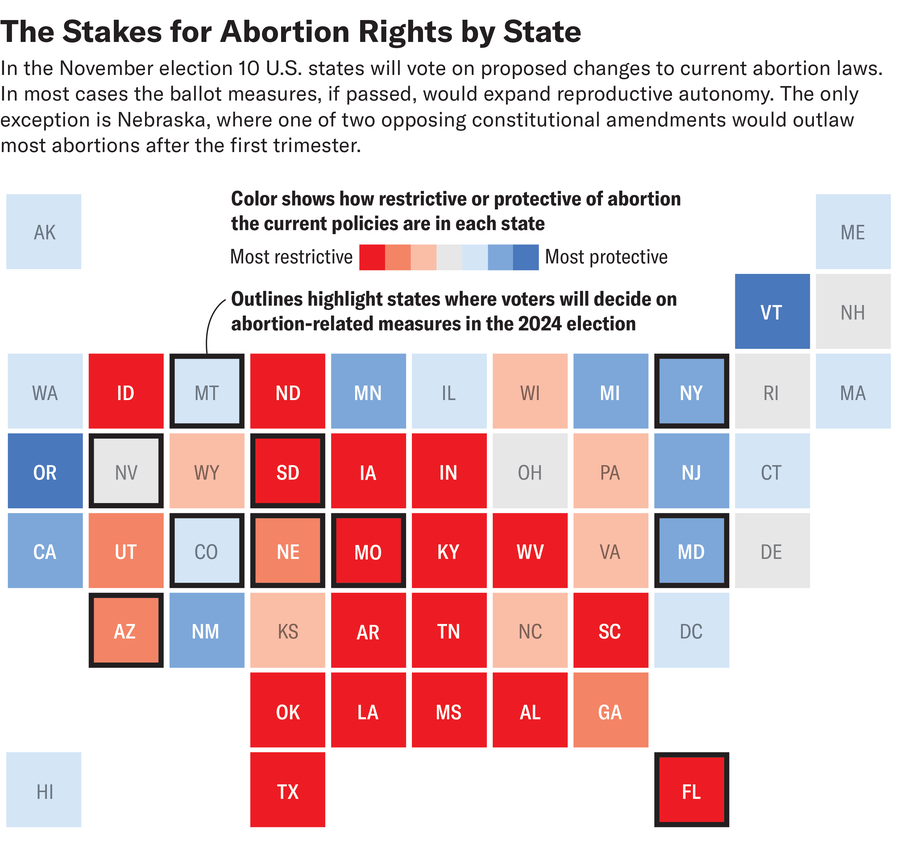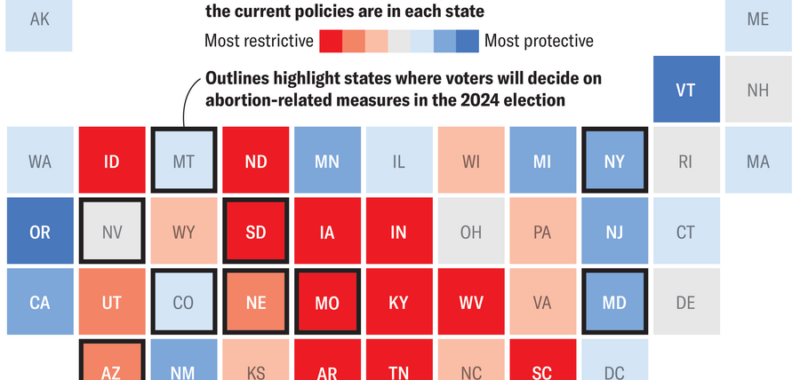Few issues this presidential election cycle have been as central and divisive as that of abortion and reproductive health care. And on these issues, the Republican and Democratic candidates couldn’t be more different. Former president Donald Trump would continue to roll back reproductive rights, whereas current vice president Kamala Harris would protect them.
During his first term, Trump appointed the Supreme Court justices who helped overturn Roe v. Wade, the constitutional protection for abortion that had stood for 50 years, in Dobbs v. Jackson Women’s Health Organization. The 2022 ruling set in motion a slew of sweeping abortion restrictions or outright bans at the state level. As of this writing, 14 states have banned the procedure and a dozen others have gestational age limits. Some states have no exceptions for rape or incest. Despite these bans, abortions have increased since the Dobbs ruling.
Trump has repeatedly taken credit for the decision, saying on his social media platform, “I was able to kill Roe v. Wade.” Although he has said he wants abortion to be decided by the states, he declined to say during the presidential debate that he wouldn’t sign a national abortion ban, should Congress pass one. (He has since said on his social media platform he wouldn’t support one.) But even without new legislation, Trump could attempt to enforce an existing 19th-century law called the Comstock Act, which nominally prohibits the mailing of “obscene” materials, including anything used to cause an abortion. The conservative policy agenda Project 2025—which Trump has distanced himself from but was written by his close allies—clearly states its intent to use this strategy to roll back abortion access.
On supporting science journalism
If you’re enjoying this article, consider supporting our award-winning journalism by subscribing. By purchasing a subscription you are helping to ensure the future of impactful stories about the discoveries and ideas shaping our world today.
Harris presents a stark contrast. The Biden-Harris administration signed multiple executive orders to protect abortion, including ensuring abortion medication can be dispensed by pharmacies. The administration also defended abortion access at the Supreme Court in response to a challenge to regulatory approval of the abortion medication mifepristone and in a case involving emergency abortion care. The Biden-Harris administration also expanded coverage of abortion-related travel and made birth control easier to access under Medicaid, the government insurance program for people with a low income.
Harris has repeatedly vowed to sign legislation protecting reproductive rights if elected. During her time in the Senate, she cosponsored legislation to ban states from imposing restrictions on abortion access. She has called for getting rid of the filibuster to allow Democrats in the Senate to pass legislation protecting abortion.
But states have a role, too: 10 states currently have ballot measures that aim to protect abortion access; one state has an opposing measure to restrict it after the first trimester.

“With a Harris administration, people will be able to be liberated and make their own choices and decisions about their bodies,” says Josie Urbina, an ob-gyn and complex family planning specialist at the University of California, San Francisco. “For Trump’s presidency, I just see it taking [things] even farther back: there being even more restrictions than there are now and him caving in to the antiabortion people.”
All state abortion bans nominally contain exceptions to protect the life of the pregnant person, but many medical providers are afraid to provide care for fear that they could lose their license or serve jail time. In the wake of Roe’s overturn, “I also see an increase in criminalization of pregnancy in that the government will have an authority over pregnant people’s bodies,” Urbina says. Several people have already been criminally charged for miscarriages or crimes related to their pregnancies, she notes.
During his debates with Biden and Harris, Trump repeatedly invoked the lie that Democrats support “abortion after birth,” a meaningless term for something that is not legal anywhere in the country. The 2024 Republican platform states that it opposes late-term abortion, ignoring the fact that the vast majority of abortions are performed early in pregnancy and that abortions in the third trimester are almost always a result of life-threatening conditions in the pregnant person or fetus.
And it’s not just abortions—routine pregnancy and reproductive care are also suffering as a result of abortion bans enacted as a result of the Dobbs decision, including standard care for miscarriages and ectopic pregnancies (pregnancies outside of the uterus that can be life-threatening if untreated). Neonatal mortality in Texas actually increased after its abortion ban was passed. “The government, and Donald Trump, certainly, should not be telling a woman what to do with her body,” Harris said during her debate with Trump.
During a second Trump term, contraception may also be under threat. Project 2025 aims to strip away access to free birth control by restoring religious exemptions to the Affordable Care Act’s contraception mandate. In 2019 the Trump administration greatly weakened the Title X family-planning network, which provides affordable birth control and preventive health services, by disqualifying funding for clinics that also provided abortions and barring abortion referrals. Under Trump, the Republican-controlled Congress eliminated the individual mandate for health insurance under the Affordable Care Act, further weakening access to reproductive health care.
The rollback of abortion rights under Trump is also threatening people’s ability to grow their family using in vitro fertilization (IVF). The Alabama Supreme Court ruled earlier this year that embryos created using IVF are considered children, prompting several IVF clinics to pause treatments out of fear that physicians and families could be prosecuted for creating embryos that were not or could not be used for a pregnancy. Other states already have fetal personhood laws on the books that providers worry could be used to jeopardize IVF.
Harris and her Democratic allies have said they will protect assisted reproductive technology. Her own vice-presidential candidate, Tim Walz, said he and his wife used fertility treatment (though not IVF specifically) to have children, and many other prominent Democrats have shared their experiences with IVF. Many Republicans support the procedure, too. Yet when Democrats in Congress twice introduced a bill that would have provided a nationwide right to IVF, Senate Republicans blocked it both times.
Fertility treatment is “a very private and emotional journey,” says Irene Su, a professor and director of the Reproductive Endocrinology and Infertility Fellowship Program at the University of California, San Diego. “And so for people who are public figures to speak about it—whether it’s about IVF or about pregnancy loss or abortion…, I think it’s a big deal in terms of in part normalizing it and in part saying this happens,” she says. “We see a lot more of that by Democratic candidates than Republican candidates.”
Trump said in the debate with Harris that he is a “leader on fertilization,” and he has claimed, without evidence, that he would make IVF free for all Americans. In fact, he doesn’t have the power to do so: Congress would have to appropriate funding specifically for one medical condition, something it has never done before. Rather than expand health care, Trump himself tried repeatedly and unsuccessfully to get the Affordable Care Act repealed while he was in office.
“On [former] president Trump’s side, there’s a lot of flip-flopping about positions,” Su says. “Statements that seem supportive of reproductive rights or IVF access cannot be implemented, and it’s inconsistent.”
Courts and state legislatures also have a lot of power to affect reproductive care, but presidents have a central role. “Long-term, the role of the president in helping to set up potential judiciary members has a long-ranging impact on the future of women’s health,” Su says. And these effects will be felt long after the next president leaves office.

